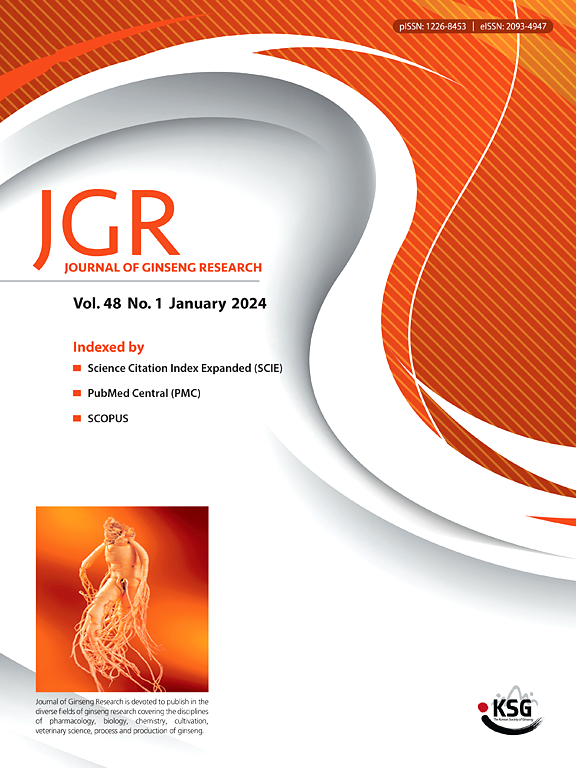Complex transcriptome network regulates the anthocyanin accumulation of four Panax ginseng cultivars in fruit
IF 6.8
2区 医学
Q1 CHEMISTRY, MEDICINAL
引用次数: 0
Abstract
Background
Panax ginseng fruit tissue is one of the richest sources of valuable constituents such as ginsenosides and anthocyanins. Although anthocyanins extracted from the fruit tissue of P. ginseng are utilized, it is uncertain how anthocyanin accumulation is regulated and which anthocyanin varieties are synthesized.
Methods
Fruits of four P. ginseng cultivars were collected for total RNA extraction and RNA-Seq analysis using the Illumina HiSeq X platform. Anthocyanins were extracted and analyzed by UPLC-DAD-QToF/MS to identify and quantify individual derivatives. Differentially expressed genes (DEGs) were identified, followed by functional annotation and network analysis to evaluate gene expression patterns.
Results
Comparative transcriptome analysis of four differently colored P. ginseng cultivars revealed that flavonoid biosynthetic genes associated with the karrikin response and jasmonate-responsive genes were upregulated in anthocyanin-rich fruits. Network analysis further revealed a putative regulatory complex consists of karrikin- and jasmonate-responsive genes along with flavonoid biosynthetic genes. Analyzing the UPLC-DAD extracts of the fruit of cv. Chunpoong found that the fruit tissue of P. ginseng is rich in pelargonidin.
Conclusion
Our research provides how anthocyanin is accumulated and which type is accumulated in fruit tissue of P. ginseng, including the original compound, pelargonidin 3-O-(2″-O-glucosyl)galactoside. We expect that our research will lead to improved breeding efficiency for the development of cultivars containing more flavonoid species that are beneficial to humans.

复杂转录组网络调控4个人参品种果实花青素积累
人参果实组织是人参皂苷和花青素等有价值成分最丰富的来源之一。虽然利用了从人参果实组织中提取的花青素,但花青素的积累是如何调控的以及哪些花青素品种是合成的还不清楚。方法采集4个人参品种的果实,采用Illumina HiSeq X平台进行总RNA提取和RNA- seq分析。提取花青素,采用UPLC-DAD-QToF/MS进行分析,对单个衍生物进行鉴定和定量。鉴定差异表达基因(deg),然后通过功能注释和网络分析来评估基因表达模式。结果4个不同颜色人参品种的转录组对比分析显示,花青素丰富的果实中,与卡里金反应相关的类黄酮生物合成基因和茉莉素反应相关的基因均上调。网络分析进一步揭示了一个假设的调控复合体,由卡瑞金和茉莉酸响应基因以及类黄酮生物合成基因组成。枸杞子UPLC-DAD提取物的分析。春蓬发现,人参果实组织中含有丰富的天竺葵苷。结论本研究揭示了花青素在人参果实组织中积累的途径和类型,包括其原始化合物花青素3-O-(2″- o -葡萄糖基)半乳糖苷。我们期望我们的研究将有助于提高育种效率,开发含有更多对人类有益的黄酮类化合物的品种。
本文章由计算机程序翻译,如有差异,请以英文原文为准。
求助全文
约1分钟内获得全文
求助全文
来源期刊

Journal of Ginseng Research
CHEMISTRY, MEDICINAL-INTEGRATIVE & COMPLEMENTARY MEDICINE
CiteScore
11.40
自引率
9.50%
发文量
111
审稿时长
6-12 weeks
期刊介绍:
Journal of Ginseng Research (JGR) is an official, open access journal of the Korean Society of Ginseng and is the only international journal publishing scholarly reports on ginseng research in the world. The journal is a bimonthly peer-reviewed publication featuring high-quality studies related to basic, pre-clinical, and clinical researches on ginseng to reflect recent progresses in ginseng research.
JGR publishes papers, either experimental or theoretical, that advance our understanding of ginseng science, including plant sciences, biology, chemistry, pharmacology, toxicology, pharmacokinetics, veterinary medicine, biochemistry, manufacture, and clinical study of ginseng since 1976. It also includes the new paradigm of integrative research, covering alternative medicinal approaches. Article types considered for publication include review articles, original research articles, and brief reports.
JGR helps researchers to understand mechanisms for traditional efficacy of ginseng and to put their clinical evidence together. It provides balanced information on basic science and clinical applications to researchers, manufacturers, practitioners, teachers, scholars, and medical doctors.
 求助内容:
求助内容: 应助结果提醒方式:
应助结果提醒方式:


